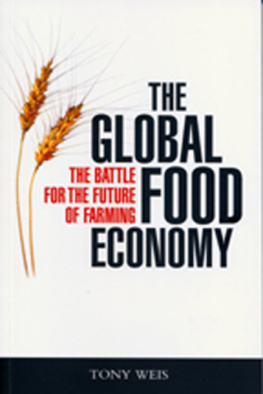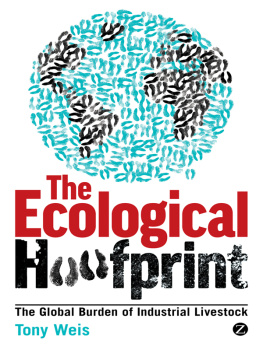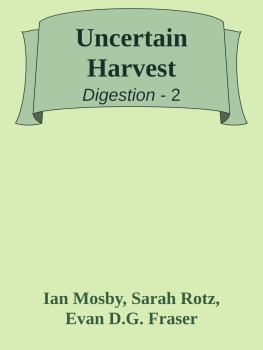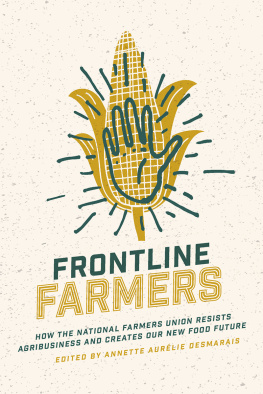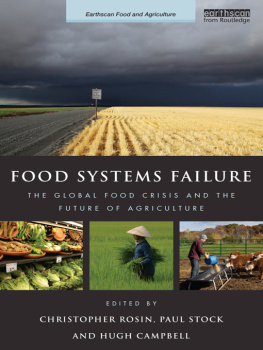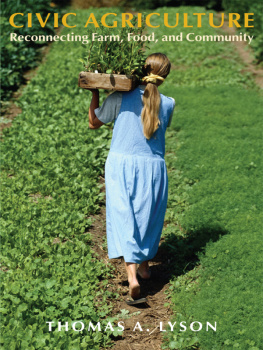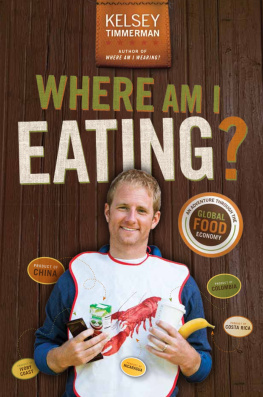
About the author
Tony Weis is Assistant Professor of Geography, University of Western Ontario, Canada. Educated at Wilfrid Laurier and Queens Universities, he is particularly interested in development policy and practice, and political ecology. He has published in various journals, including the Canadian Journal of Development Studies, the Journal of Agrarian Change, Global Environmental Change, and Capital, Nature, Socialism .

The global food economy: the battle for the future of farming was first published in 2007
Published by Zed Books Ltd, 7 Cynthia Street, London N 1 9 JF , UK and Room 400, 175 Fifth Avenue, New York, NY 10010, USA
Copyright Tony Weis, 2007
The right of Tony Weis to be identified as the author of this work has been asserted by him in accordance with the Copyright, Designs and Patents Act, 1988.
Cover designed by Andrew Corbett
Set in Sabon and Gill Sans Heavy by Ewan Smith, London
Index:
Distributed in the USA exclusively by Palgrave Macmillan, a division of St Martins Press, LLC , 175 Fifth Avenue, New York, NY 10010, USA .
A catalogue record for this book is available from the British Library. US CIP data are available from the Library of Congress.
All rights reserved
No part of this publication may be reproduced, stored in a retrieval system or transmitted, in any form or by any means, electronic or otherwise, without the prior permission of the publisher.
eISBN 9781848136885
Preface
Different worlds of food and farming
I am writing from an immersion in two radically different worlds of food and farming. I am one generation removed from a farm upbringing in southern Ontario, a region that is home to some of the best agricultural land in Canada, and my familial history is a fairly common one for multi-generation European descendants in this country. My grandfather owned an 81-hectare farm, where he raised mostly beef cattle from grains and pasture. When his children saw their future elsewhere, he retired from farming, moved on to a successful business, and sold most of his land while entrusting the last piece as a community park. His sister, my great-aunt, worked a similar-size farm with her husband on which grain production was geared towards feeding a small herd of dairy cattle. She still lives in the same farmhouse but because none of her children or grandchildren farms, the land is mostly leased. Now in her late eighties, she still feeds herself through the year largely out of her impressive kitchen garden, canning, pickling and freezing to sustain her between seasons. A few years ago she commented to me that her district, which was home to about thirty farm families a generation ago, is now mostly operated by one man who leases or has bought most of the land, and his million-dollar machinery and hired workers. While both my grandfather and great-aunt had successful farms and raised happy and healthy families on their land, farm operations of their scale would be economically marginal in Ontario today. The 20 kilometres or so between their two farms is now dotted with large, tin-sided warehouses full of animals, and on a recent summer drive through the area I didnt see a single cow; one never sees a pig or chicken raised outside in such agro-industrial landscapes, though occasionally one might see a pig carcass lying at the end of the road waiting for dead-stock pick-up.
Canada is one of the richest and most agriculturally productive nations in the world. And yet, as in most of the temperate world, agricultural bounty does not imply a sizeable or stable farming population. On the contrary, agricultural productivity comes from fewer and fewer and larger and larger farms. Canadas farm population is about one-quarter of what it was at the time of the Second World War and shrinking, and for most young people it is simply unfathomable to think about entering farming today a situation that is familiar throughout the temperate heart of the global food economy. Typical of industrial farming everywhere, the protracted pressure has been to get big or get out with the high cost of land and equipment and the steady, long-term declines in prices.
In the time that I have been working on this book farmers have taken to their tractors to block a main thoroughfare in the city where I live, and on another occasion farmers from across the province drove a series of highway-blocking tractor caravans to the provincial legislature in Toronto, hoping to draw popular and political attention to the desperate economic situations on the provinces remaining family farms. Nearby countryside some of the best farmland in this country is increasingly marked with signs that read Farmers Feed Cities and Support Our Farmers, in an attempt to draw some broader attention to the struggles of farmers and the future of farming. Also in the time that I have been writing there was a heated conflict between a suburban community sprawling on to southern Canadas largest, but still tragically small First Nations reserve, the Six Nations. The current land of the Six Nations is a fraction of the watershed that had been promised by the British, as their land was eaten into over time by European settler agriculture, towns and cities, including the city where I grew up and the farms of my grandfather and great-aunt. Following not long after the farmers protests, this conflict set in stark relief the fact that the ongoing social dislocation associated with industrial agriculture here, as in other neo-European landscapes across the temperate world, is layered on top of longer histories of expropriation that have not just vanished.
But the fleeting attention given to these events was only a blip in the longer-term unconsciousness about food, agriculture and how history lives in our landscapes, which is certainly not unique to Canada. And there are compelling reasons why most citizens of industrialized and fast-industrializing countries might give little thought to their food; the volume and apparent diversity could well seem endless. For the worlds affluent countries and classes, a global palate is at our doorstep as never before. For instance, the average US and Canadian supermarket has 12,000 items for sale, a range scarcely imaginable a generation or two earlier. The largest volume of items would invariably be drawn from grain and livestock products, processed and combined in various ways, but an ordinary supermarket might also include tomatoes from Mexico, grapes from Chile, mangoes from Brazil, cut flowers from Colombia, shrimp from Thailand, cheese from New Zealand and oranges from South Africa, along with processed goods with derivatives sourced from far away.
In addition to the supersized supermarkets, in the mid-sized city where I live I can walk downtown and eat at a British, Chinese, East African, Hungarian, Indian, Italian, Japanese, Greek, Latino American, Lebanese, Mexican, Moroccan, Thai or Vietnamese restaurant, and an array of other eclectic, independent eateries, the sort of cosmopolitanism which is surely one of the great benefits of globalization, however much this sort of diversity conceals the standardization and a host of problems in the agricultural system supplying the food. On that same short walk, I would also see a McDonalds, Burger King, Subway, KFC, Starbucks and Quiznos, and a number of other fast-food chains.

